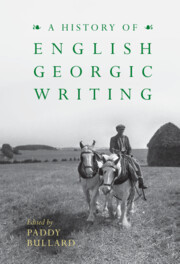Book contents
- A History of English Georgic Writing
- A History of English Georgic Writing
- Copyright page
- Contents
- Contributors
- A Note on National Designations
- Abbreviations
- Introduction
- Part I Turnings
- Chapter 1 Hesiod, Virgil and the Ambitions of Georgic
- Chapter 2 Turning, Flying
- Chapter 3 Farm Diaries, 1770–1990
- Chapter 4 Twentieth-Century Georgic and Agricultural Technology
- Part II Times
- Part III Territories
- Bibliography
- Index
Chapter 2 - Turning, Flying
The Rural Year
from Part I - Turnings
Published online by Cambridge University Press: 01 December 2022
- A History of English Georgic Writing
- A History of English Georgic Writing
- Copyright page
- Contents
- Contributors
- A Note on National Designations
- Abbreviations
- Introduction
- Part I Turnings
- Chapter 1 Hesiod, Virgil and the Ambitions of Georgic
- Chapter 2 Turning, Flying
- Chapter 3 Farm Diaries, 1770–1990
- Chapter 4 Twentieth-Century Georgic and Agricultural Technology
- Part II Times
- Part III Territories
- Bibliography
- Index
Summary
Virgil promises a calendar of times and tasks in his Georgics, yet the temporal leaps in his poem take us far from steady calendrical form. This essay asks how his English inheritors have evoked repeated annual cycles while also expressing idiosyncratic understandings of time and local particularities of work. The first section argues that the medieval iconography of the ‘labours of the months’ provides an important and neglected context for study of georgic writing, and enquires into the parallel influence of another iconographic tradition: that of illustrations to Virgil. Subsequent sections focus on writers (including Thomas Tusser, Mary Collier, William Cowper and Ford Madox Ford) who develop literary forms for their calendrical material and in doing so question the very shape and meaning of rural life. Where are the year’s pivots and culminations, does it take different form for men and women, does it begin or end?
- Type
- Chapter
- Information
- A History of English Georgic Writing , pp. 57 - 78Publisher: Cambridge University PressPrint publication year: 2022

